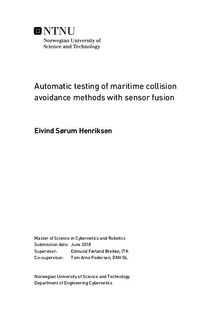Automatic testing of maritime collision avoidance methods with sensor fusion
Master thesis
Permanent lenke
http://hdl.handle.net/11250/2562121Utgivelsesdato
2018Metadata
Vis full innførselSamlinger
Sammendrag
The development of Autonomous Surface Vessels (ASVs) has during the recent years seen a greatprogress. When being completely developed, these vessels may be used in a variety of scientificand commercial operations, eventually leading human based operations redundant.
An ASV needs a well-functioning Collision Avoidance (COLAV) system in order to operateat sea where other obstacles such as vessels and land are present. In addition of beingable to handle collision situations, the COLAV system needs to comply with the rulesfor avoiding collision at sea (COLREGS). To retrieve the necessary information of thesurroundings, the COLAV system utilizes a number of information sources. This may includeexteroceptive sensors such as radar and cameras, or communication-based solutionssuch as the automatic identification system (AIS). In order to enable COLAV, the sensorinformation needs to be included into the state estimation of the surrounding obstacles.This is done by the use of a tracking system.
In this thesis, a COLAV system including a multi-target tracking system based on the JointIntegrated Probabilistic Data Association Filter (JIPDAF) and two COLAV algorithms,one based on the Velocity Obstacle (VO) and another method called Scenario-Based ModelPredictive Control (SBMPC), has been tested in a wide variety of ASV scenarios. The scenariosare generated with a new method which challenges the COLAV system to a highnumber of succeeding vessel interactions. To evaluate the COLAV system s scenario performance,a number of evaluation metrics used to determine COLREGS compliance areapplied.
The COLAV system have been implemented on a Platform Supply Vessel (PSV) and thetesting has taken place in a simulated environment. The results from the testing show thatwhen exposed to a small amount of noise, the tracking system delivers accurate obstacleestimates to the COLAV algorithm, resulting in good evaluation scores. In more challengingscenarios which includes considerably more noise, the tracking system delivers morefluctuating obstacle estimates and a high number of false tracks, resulting in poor performanceof the SBMPC algorithm, while the VO algorithm performs remarkably well.
